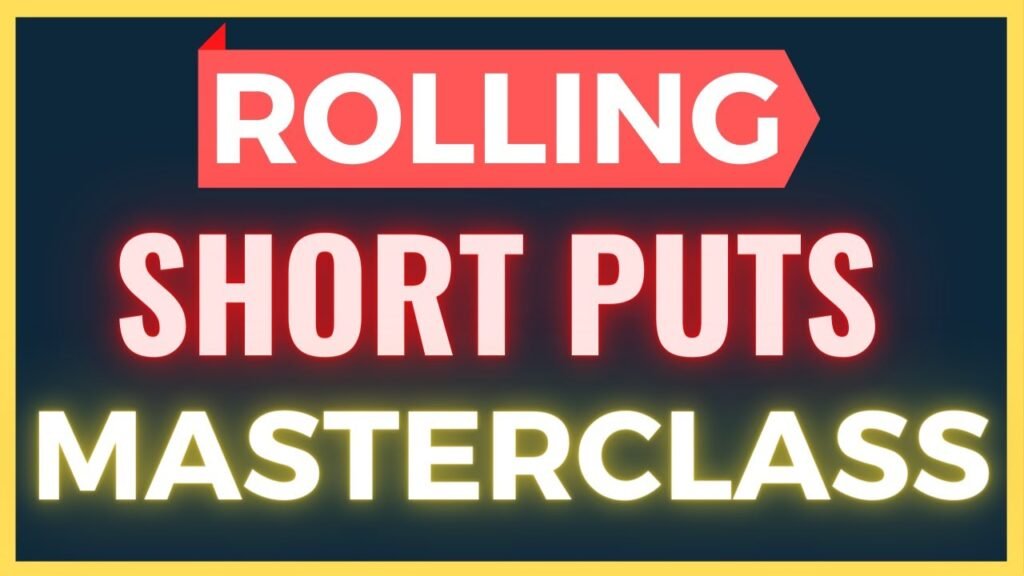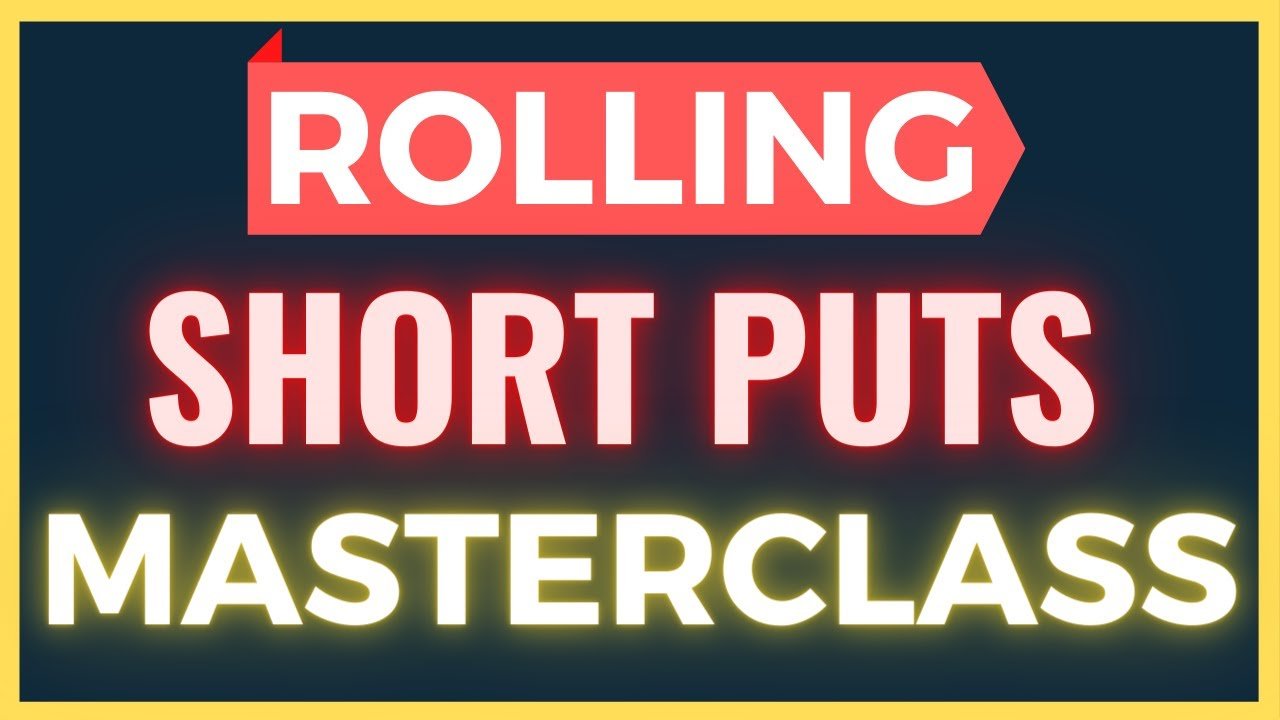Welcome to the Rolling Short Puts Masterclass! In this comprehensive video, Options with Davis provides expert guidance on how and when to roll short puts. Rolling short puts involves closing out your current option position and simultaneously opening another position in one order ticket. The goal is to receive a credit for the new position. This masterclass covers various types of short put rolls, scenarios in which rolling is recommended, and systematic methods for successful rolling. With beginner-friendly explanations and a focus on options trading strategies, this video is a valuable resource for traders looking to enhance their knowledge and improve their profitability. So, get ready to roll your short puts like a pro and make the most of your options trading journey!
Section 1: Introduction
Welcome to the Masterclass on rolling short puts! In this comprehensive article, we will explore the basics of rolling short puts, the different types of short put rolls, when to roll short puts, and systematic methods for rolling. Whether you’re a beginner or looking to enhance your options trading strategies, this article will provide you with the knowledge and insights you need to roll your short puts like a pro.
Section 2: Basics of Rolling Short Puts
2.1 What is Rolling Short Puts?
Rolling short puts refers to the process of closing out a current option position and simultaneously opening another option position in one order ticket. It involves buying back your current short put and then selling another put option. The key objective of rolling is to receive a credit for the new position.
2.2 Goal of Rolling
The primary goal of rolling short puts is to improve the probability of profit. By rolling to a lower strike price, you increase the chances of capturing potential profits even if the market drops. Rolling also allows you to extend the trade duration and reduce the chances of getting assigned on the option.
2.3 Reasons to Roll Short Puts
There are several reasons why you may consider rolling a short put:
- Improve the probability of profit: Rolling to a lower strike price allows you to capture profits at a lower level if the market drops.
- Give more time for the trade to work out: Rolling extends the expiration date, providing additional time for the market to recover and for the option to expire worthless.
- Reduce the chances of getting assigned: Extending the expiration date reduces the likelihood of early exercise, giving you more control over when you may be assigned on the option.
- Get a better assignment price: Rolling down to a lower strike price can result in a more favorable price if you do get assigned.
- Cost basis reduction: By receiving credits through rolling, you can reduce the overall cost basis of the stock if you get assigned.
In the following sections, we will dive deeper into the different types of short put rolls and explore scenarios in which rolling is beneficial.

Section 3: Types of Short Put Rolls
3.1 Rolling Out
Rolling out refers to rolling the short put to a further expiration date while keeping the same strike price. By adding more time, rolling out allows for extended trade duration and the potential for the market to recover. In most cases, rolling out results in a credit for the new position.
3.2 Rolling Out and Down
Rolling out and down involves rolling the short put to a further expiration date and lowering the strike price. This move allows you to capture potential profits at a lower level and also reduces the chances of assignment. While rolling out and down can result in a credit, it is essential to assess the market conditions and make a decision based on your risk tolerance.
3.3 Rolling Up
Rolling up is the least common type of short put roll. It involves rolling the short put to a higher strike price, allowing you to capture potential profits from a strong upward move in the market. Rolling up may not always result in a credit, but it can offer opportunities for increased profit potential.
In the following section, we will discuss when it is appropriate to roll short puts and the different scenarios that warrant rolling.
Section 4: When to Roll Short Puts
4.1 Scenarios for Rolling Short Puts
Rolling short puts should be done in specific scenarios where the current position is in the money, at the money, or out of the money, and the market is expected to go up. It is crucial to assess the market conditions, analyze the option’s extrinsic value, and consider the expiration date before deciding to roll.
4.2 Rolling Down vs. Other Types of Rolls
When considering rolling, it is essential to weigh the costs and benefits of rolling down (lowering the strike price) versus other types of rolls. Rolling down will always incur a debit, meaning you will pay for the new position. On the other hand, rolling out and rolling up can potentially result in a credit, providing you with additional income. It is generally recommended to avoid rolling down unless there is a specific reason to do so.
In the next section, we will explore a case study on rolling up a short put, highlighting the decision-making process and the results of rolling.
Section 5: Case Study: Rolling Up a Short Put
5.1 Author’s Decision to Roll Up
In this case study, the author decided to roll up their short put rather than letting it expire. The decision was based on a strong upward move in the market, indicating potential profit opportunities.
5.2 The Process of Rolling Up
The author bought back the current short put at a certain strike price and sold another put option at a higher strike price. By rolling up, the author extended the expiration date and created a new position with increased profit potential.
5.3 Results of Rolling Up
Rolling up the short put resulted in a credit of $243 for the new position. While the author did not get filled at the initial strike prices, they still made a profit of $1,700. This case study illustrates the potential benefits of rolling up a short put when there is a strong upward move in the market.
In the next section, we will discuss the difference between rolling short puts in the money and at the money, and the considerations for each scenario.
Section 6: Rolling Short Puts In the Money vs. At the Money
6.1 Difference Between In the Money and At the Money
When rolling short puts, it is essential to understand the difference between in the money and at the money. In the money refers to a scenario where the market price of the stock is below the strike price of the put option. At the money refers to a scenario where the market price is close to the strike price.
6.2 Benefits of Rolling In the Money
Rolling short puts when they are in the money allows for more time for the market to recover and the extrinsic value of the option to decrease. This can increase the probability of capturing potential profits and reduce the chances of assignment.
6.3 Considerations for Rolling At the Money
Rolling short puts when they are at the money requires active management and monitoring. It allows for perpetual rolling until the furthest expiration date, providing opportunities for continued profit potential. However, it may take longer to realize profits, and careful attention to market conditions is necessary.
In the next section, we will explore systematic methods for rolling short puts, providing you with structured approaches to rolling.
Section 7: Systematic Methods for Rolling Short Puts
7.1 Three Systematic Methods for Rolling
There are three systematic methods for rolling short puts that can help guide your decision-making process:
- Rolling immediately when it touches the strike price: This method allows for more time for the trade to work out and provides an opportunity to adjust the strike price. However, it can be challenging to roll down if the option is deep in the money, and rolling for a credit may be difficult.
- Rolling when it is at the money: Rolling at the money allows for perpetual rolling until the furthest expiration date. While it takes longer to realize profits, it requires active management and monitoring.
- Rolling when it breaches the break-even point: This method gives more time for the trade to work out and has a low probability of getting assigned. However, it may not allow for rolling the strike price down as far as the at the money roll and also requires active management.
By following these systematic methods, you can approach rolling short puts with a structured plan to maximize profit potential and manage risk effectively.
Section 8: Conclusion
Rolling short puts can be a valuable tool for options traders to increase profit potential, extend trade duration, and manage risk. By understanding the basics of rolling, the different types of short put rolls, and when to roll in different scenarios, you can make informed decisions and optimize your trading strategies. Remember to assess market conditions, consider risk tolerance, and follow systematic methods for rolling to enhance your options trading experience. Happy rolling!
